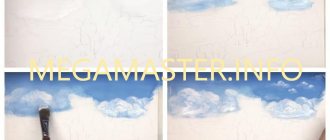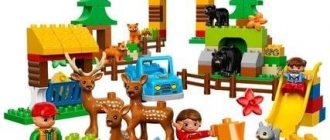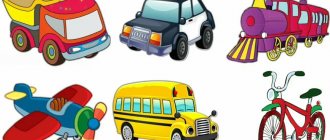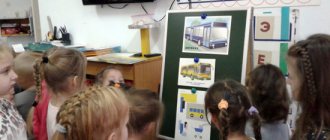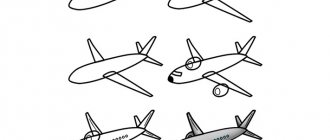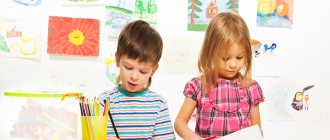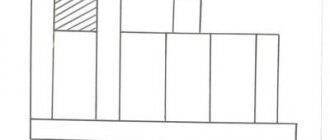Summary of the drawing lesson “Bus”. Middle group
Yulia Essina
Summary of the drawing lesson “Bus”. Middle group
Abstract on the educational field “artistic and aesthetic development”
Drawing ( middle group )
Topic: " Bus "
Educator: Essina Yu. V.
Goal: to teach children to convey rectangular, square and round shapes in a drawing, to draw an object large , in accordance with the size of a sheet of paper, to maintain proportions.
1. To develop children’s knowledge about transport and its types; convey the shape of the main parts of the parts, their size and location.
2. Form rules for painting with paints: in one direction (from left to right or from top to bottom)
with the entire brush, tearing it off the paper and each time bringing it to the outline.
3. To develop interest in drawing , artistic taste, attention and logical design in drawing , creative thinking and imagination.
4. Continue to develop the ability to evaluate your own drawings and the drawings of other children.
5. Cultivate a desire to help other people.
Equipment and materials: pictures depicting various types of transport, album sheet, gouache, water jar, brush, napkin for each child.
Methods and techniques: a surprise moment, a teacher’s story, looking at illustrations, showing actions, asking questions to children.
Preliminary work: conversations about transport, looking at illustrations depicting transport, looking at transport toys.
Summary of drawing lesson “Boat”
Summary of drawing lesson “Boat”
Middle group
Target:
promote the development of productive and creative activity through drawing.
Tasks:
- educational: teach children to create a simple composition - a boat floating in the sea; consolidate knowledge about types of transport;
— developing: development of fine motor skills, color perception, sense of shape and composition;
— educational: to cultivate interest in visual arts.
Type of activity
– introductory.
Integration of educational areas
: “Cognition”, “Artistic and aesthetic development”, “Socio-communicative development”, “Physical development”.
Activities
: communicative, playful, productive, motor.
Methods
– verbal, visual, playful, practical.
Forms of cognitive activity of children:
— frontal;
- group.
Material and equipment:
images of various transport, sea, sky, earth, mosaic, counting sticks, pencils, sheets of white paper, paints, brushes, projector, multimedia board, laptop.
Preliminary work:
conversation about types of transport, about the profession of a driver, pilot, ship captain, looking at illustrations.
Progress of educational activities
| Stages | Content |
| Organizing time | -Hello, children, I’m glad to see you all again, you are very beautiful and joyful today, let’s give our guests a piece of your good mood, we’ll all say in unison: “Hello!” and smile. |
| Didactic game “Modes of Transport” | - Guys, go to the chairs and look at the pictures. What do they show? I will show a picture with a pointer, and you tell me the name! — How can all this be called in one word? - Look, I still have three illustrations here - sea, sky and earth. Who can guess why we need them? How can they be related to transport? — That’s right, there is air, water and land transport. - So let's divide our transport images into appropriate groups. Where should I put the bus? Why? What about the balloon? Etc. with all the pictures. |
| Conversation about water transport. | - Look, guys, Captain Vrungel has arrived as our guest today! What does he travel on? What type of transport is this? (Image on slide) — What other water transport do you know? -Where can I meet them? — What is the name of the place where ships sail? Look at the picture of the port on the board. —What types of ships are there? (Military, passenger, cruise, etc.) — What parts does the ship consist of? |
| Laying out ships from counting sticks, pencils, mosaics. | - Come, children, to the tables, sit down. Try to build a ship from the items offered to you. - Okay, well done, now let’s rest a little and play! |
| Physical education minute | Outdoor game “Modes of Transport” The teacher names the transport, and the children if it: - water transport, imitate swimming with hands; — air transport, simulate the flight of an airplane; - ground transport, twirl their arms in front of them, depicting a pinwheel. |
| Creating a problematic situation. | Guys, Captain Vrungel told me very sad news, his comrades were shipwrecked at sea and stuck on a desert island. Now they have nothing to get to the ground with. He asks for help. Can you and I help them? How? That's right, we can draw boats with you! |
| Showing techniques for drawing a boat. | Look carefully at how we will draw them. (The teacher explains the techniques and sequence of drawing a boat.) |
| Independent activities of children | So, guys, you've seen how you can draw a boat, now let's start working on your own. |
| Reflection | What beautiful boats you have made! Why did we draw them? We completed our task. Well done, travelers thank you all for your help! |
Summary of drawing lesson “Bus”
Daria Afonina
Summary of drawing lesson “Bus”
"Bus". Lesson summary for an early age group.
Goal: To introduce children to passenger transport - a bus, and to give them an idea about it.
Objectives: -To strengthen the ability to hold a brush correctly;
-Develop attentiveness and perseverance, memory;
-instill interest in drawing;
-Develop the ability to carefully color a drawing without going beyond the contours;
Summary of a drawing lesson “Bus” outline of a drawing lesson (middle group)
Topic: “The bus is driving along the road”
Goal: to consolidate ideas about transport and traffic rules. Strengthen the ability to depict an object, learn to draw an object large, consolidate the technique of painting in one direction, observing the rules of shading, and add details. Encourage children to independently enrich the image and develop their imagination.
Materials and equipment for the lesson:
- demonstration: illustrations depicting a bus or
toy bus, sample work, outlines (rectangle, circle, square) for each child.
- handout: half a landscape sheet, crayons (pencils).
Progress of the lesson:
Organizational moment: communicative game “Good morning”
“We will hold hands, smile at each other
Good morning eyes, good morning ears,
Good morning hands, good morning feet,
GOOD MORNING GUESTS!”
Educator: - Guys, let's remember the work of K.I. Chukovsky “Cockroach”. What did the heroes of the fairy tale ride? (Bears on a bicycle, bunnies on a tram, a toad on a broom, mosquitoes on a balloon.) Tell me, how did you get to kindergarten? (By bus, by dad’s or mom’s personal car.) How can you call everything you listed in one word? (Transport.)
Educator: now I will show you pictures of transport, and you will say the name of this transport. (I show and the children name).
Teacher: “Guess the type of transport by ear.”
The teacher takes turns playing for the children a recording of characteristic noises and signals produced by various types of transport - the sound of a running car engine, the whistle and knock of train wheels, the whistle of a steamship, the rumble of an airplane. After listening to a fragment of the recording, children must determine which type of transport the characteristic noise corresponds to.
Educator: Guys, let's remember: transport that flies across the sky is called ...... (air transport - from the word air). Transport that travels on the ground is called……… (ground – from the word earth). Transport floating on water – ……..(aquatic from the word water).
Educator: Well done, guys! You see, it turns out that there is so much air, land and water transport in the world. Why does a person need it? Children's answers (to transport goods, people). Educator: correct. Man invented cars to make it easier to work, move or transport something. Vehicles that transport goods are called freight transport. What do you think - can air, land and water transport be freight? That is, can an airplane deliver and transport cargo? Children's answers. Educator: Can ground transport be called freight? Children's answers. Teacher: yes, that's right. Well, can a water boat be a cargo ship? Children's answers. Educator: Well done. Then answer me this question: can air, land, and water transport also be passenger transport? Transport passengers - people? Children's answers. Educator: everything is correct. Let's now remember the rules of the road. I suggest you play a game called “Traffic Light”. Now you will all turn into drivers. I have a traffic light. If I show a green circle, you can move - drive, if I show a red circle, then... children's answers (we will stop). Well, if the yellow light comes on, then the cars should get ready and start honking. Now let's check how you remember everything. And to start the game, let's start the engines! (rrrrrrr), we press the gas pedal (press our foot to the floor) and the children begin to move, imitating the turns of the steering wheel, and the teacher controls the movement..
At the end of the game, at the teacher’s signal, the drivers park the cars in their chairs.
Educator: Guys, if today we all wanted to go to the zoo together, what would we go on? (bus, trolleybus). Why? (not very far, need a lot of places)
I have a bus (picture of a bus), let's look at it (and touch it). What does the bus have? Name the main parts of the bus. (Wheels, body, windows, headlights).
Educator: That's right, but why does he need wheels? (To move along the road). What shape are they? (Round) What color are the wheels? (black)
Educator: Okay. Why does a bus need windows? (So that people can see where they are going). What shape are they? (Square or rectangular). What color are they? (Blue or light blue)
Educator: Tell me, why does the bus need headlights? (To move in the dark)
What color are they? (yellow)
Educator: Tell me, what shape is the body of the bus? (Rectangular)
What color is it? (Different colors)
Physical exercise “We are drivers”
We're going - we're driving a car, (we turn the steering wheel with our hands)
We press the pedal. (We bend and unbend the leg)
We turn the gas on and off (Move your hand forward and backward).
We look intently into the distance. (Palm to forehead, we peer into the distance.)
The wipers wash away the drops (Arms bent at the elbows in a motion)
Right and left - clean! (Left - right).
The wind ruffled my hair. (Rush your hair).
We are drivers – no matter where you go! (Extend your thumb).
At the end, the children take chairs and take their places at the table.
Educator: Look how I will draw a bus driving along the road. Drawing a bus drawing is easy because it consists of simple shapes. You have outlines on your table. First, you need to outline a large rectangle with black chalk. This will be the body of the bus. It occupies the main part of the sheet. Then we will draw a circle twice, these will be the wheels. Using small rectangles we will draw the windows of the bus. Please note that the driver's window should be separate from the other windows, so we will separate the first window with a line. Let's draw the headlights. All that remains is to shade the bus and it will be ready for transportation! Now let's get to work.
While working, remember the rules of shading (when painting a drawing, you must not go beyond the contour of the drawn object; strokes must be applied in one direction: from top to bottom, from left to right, or obliquely; you need to paint over the drawing without gaps; you need to press evenly on the pencil: press harder if you want paint it brighter, and weakly - if you need to paint it lighter).
Analysis of work, lesson summary:
Everyone who did not have time to finish drawings will be able to finish the drawings after sleep.
— Guys, did you like your drawings? And I really liked it. You all worked really hard today. What did you enjoy doing most today? (answers).
Surprise moment: I want to give you stickers, before lunch we will carefully paste them in and make a “Transport” album.
On the topic: methodological developments, presentations and notes
By developing the cognitive interest of preschoolers through various types of activities, including visual arts, it is possible to achieve a significant increase in the level of ideas about the world around children. During the course
To cultivate a moral and aesthetic attitude through the depiction of animals.
This lesson introduces children to nature (trees and shrubs), allows them to teach children how to draw trees and shrubs correctly. The following methods were used in the lesson: gaming, verbal, practical.
Lesson notes on visual arts (modeling - experimentation). Topic: “Tili-tili dough...”
Lesson summary on visual arts (preparatory group) TOPIC: “Fairytale autumn forest.”
Source
How to draw a truck step by step in 5 steps
In this section I will show you how to draw a truck step by step.
You can draw it by hand while looking at your computer monitor, or print this page for more detailed instructions on each step. Follow the red line in each illustration to find out exactly what to draw in this step. Lines drawn in previous steps are shown in gray. I'll show you illustrations of each step and then give you a description of how to draw it.
1. Draw an outline
Connect two vertical rectangles to form a cabin. On the lower right side, add a U-shaped shape lying on its side. Draw a straight and curved line vertically inside the U-shape to show the outline of the rear tires.
Form three full tires. Attach the bottom of the unfinished oval to the bottom of the front tire. To the left of the two rear tires, add a partial oval. On the left side, draw two unfinished ovals. Above and to the left of the rear tire, add a long straight line from right to left.
3.
Wheels and gas tank
Draw a rectangle for the bumper and the cab roof line. Add a cylinder for the gas tank. Draw ovals for the tires and lines dividing the tires. Decorate the roof of the truck. Erase all unnecessary lines from the previous step.
4.
Windshield and Grille
For the windshield, draw a rectangle. Add two slanted lines with circles on one end and double lines on the other for the windshield wipers. Draw the shape of the front grille. On either side of the grille, draw a circle inside another circle for the headlights. Add four small rectangles on the front bumper for the side lights and turn signals. Draw four curved lines like the straps on the fuel tank.
5.
Add Details and Shading
Draw the shape of the door and window using three rectangles. Add a tiny rectangle to the door for the handle. Fill in the dark areas as shown in the picture.
Your car drawing is finished! Even if you don't get it right the first time, keep practicing until you get it right!
Source
Learning how to draw a truck
Good afternoon, boys, rejoice, today's lesson is for you! Today we are learning how to draw a truck with a step-by-step drawing of each element. This drawing is very simple, so even a child or a parent can easily draw it for their child.
Our truck is rushing along the highway to do its delivery business. It is red with a van body, but you can make it absolutely any other color, as well as with any other body, for example, a dump truck. It all depends on your imagination.
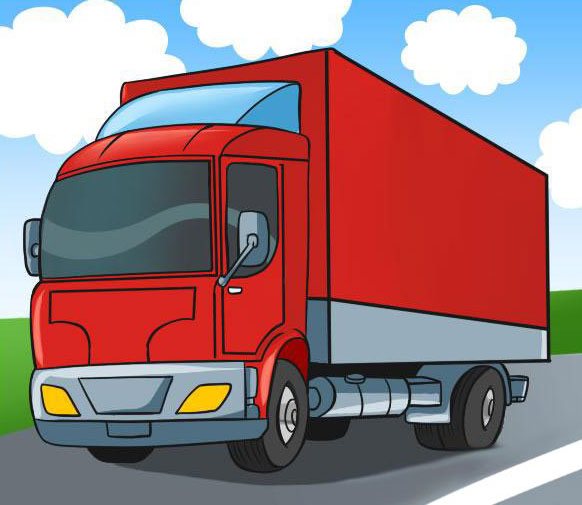
how to draw a truck
So let's get started. To make it easier for you to learn how to draw a truck , at each stage we have marked in red those lines that need to be drawn exactly at the step being described.
Step 1 To draw a truck we will need a ruler, an eraser and a pencil. It is advisable to choose an HB pencil as it is best for simple sketches. Let's draw guide lines as shown in the figure.
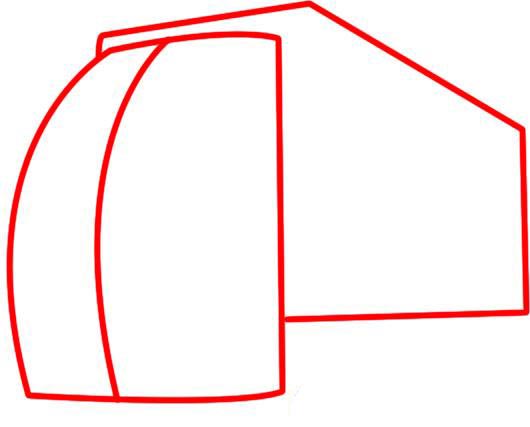
Drawing the main lines of the truck
Step 2 Next, draw the outlines of the truck cabin.
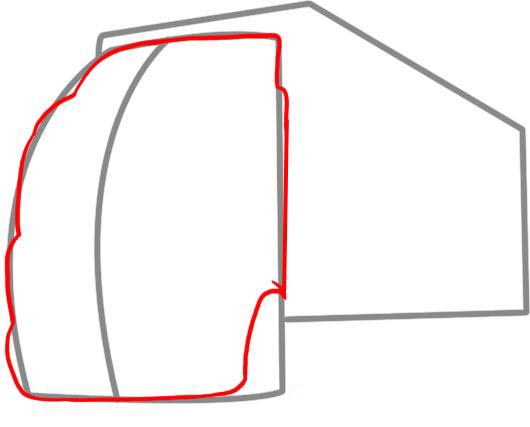
Drawing the contours of the cabin
Step 3 Next, use a ruler to draw the corners of the cargo compartment. Now let's draw the windshield, door and side mirror.
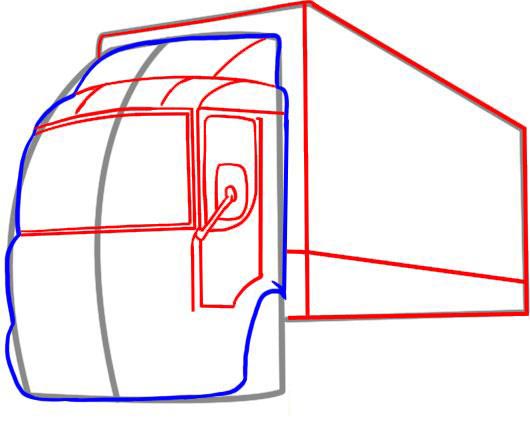
Drawing a truck van
Step 4 Next, draw the remaining parts of the front of the truck: bumper, headlights, air vents, door handle and second side mirror. Drawing trucks is not very difficult as they have straight lines, if you learn how to draw a truck you will be able to draw other large cars and buses.
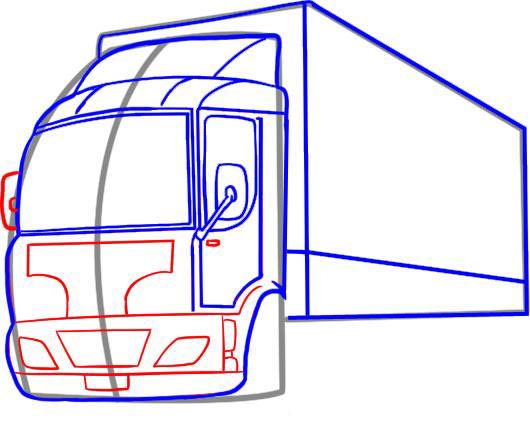
Draw a truck bumper and radiator
Step 5 Now draw the wheels as shown in the picture.
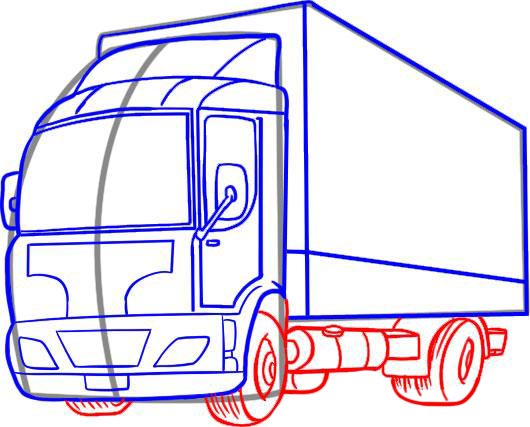
Draw the wheels, tank, frame and wings of the truck
Step 6 That's it. The drawing on how to draw a truck is ready. Now you can color it to your liking.
Summary of OOD on drawing in the middle group of children on the topic “Transport”
Daria Tokareva
Summary of OOD on drawing in the middle group of children on the topic “Transport”
Summary of OOD on drawing in the middle group of children on the topic “ Transport ”
Completed by Tokareva D.N., teacher at MBDOU “Kindergarten of compensatory type No. 4”
,Voronezh city
-develop visual perception of color and size;
-develop memory, thinking, attention;
- evoke positive emotions in children ;
- learn to work carefully with paints;
- be respectful of the results of the creativity of your peers.
-improve the technique of using a brush (the end of the brush, the brush with a poke)
;
- develop fine motor skills of the hands;
-development and activation of the dictionary;
-develop auditory attention, coordination of speech with movement.
- make sentences based on pictures.
-control children’s posture while drawing ;
- physical minute “We’re going, we’re going by car...”
;
- didactic game “The fourth odd one”
;
-articulation gymnastics “Door”
,
“Clock”
,
“Woodpecker”
,
“Motor”
).
Methodological techniques, surprise moment, questions, game, use of PC,
reminder, individual assistance.
Preliminary work: -in individual lessons we read poems about transport , learned riddles;
Summary of a lesson on subject drawing in the secondary group “Transport”
Sagdeeva Guzaliya
Summary of a lesson on subject drawing in the secondary group “Transport”
Summary of a lesson on subject drawing in the middle group on the topic : “ Transport ”
.
— Teach children to create images and simple plots based on their imagination.
— Continue to develop aesthetic perception of the world around us.
— Draw children’s attention to the figurative expressiveness of various objects of art.
Educational: Consolidate children's knowledge about transport and its types; make you want to draw land , water, and air transport with colored pencils.
Developmental: Develop the ability to work according to a model; attentiveness, perseverance, memory, fine motor skills.
Educators: Cultivate an interest in drawing , a desire to help friends.
Material and equipment: “Carlson”
, pictures depicting
transport (passenger car, truck, bus, train, ambulance, fire department, excavator, airplane, helicopter, ship, samples of the transport drawing , magnetic board, tape recorder, recording of instrumental music, colored pencils, A 4 album sheets.
Preliminary work : memorizing poems about transport , talking about types of transport , looking at illustrations depicting transport .
